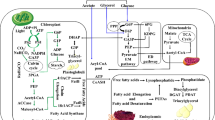Abstract
This research investigated the potential for methanotrophic biotransformation of three HCFCs — chlorodifluoromethane (HCFC-22); 1-chloro-1,1-difluoroethane (HCFC-142b); and 1,1-dichloro-2,2,2-trifluoroethane (HCFC-123); and one HFC — 1,2,2,2-tetrafluoroethane (HFC-134a). All of these compounds were biotransformed to differing degrees by methanotrophic mixed culture MM1. Rates of transformation were obtained by monitoring disappearance of the target compounds from the headspace in batch experiments. Henry's constants were determined over a range of conditions to enable estimation of the intrinsic rates of transformation. Intrinsic rates of transformation were obtained by combining a second order rate expression with an expression describing loss of transformation activity due to either endogenous decay or product toxicity. For HCFC-123 and HFC-134a, the independently measured endogenous decay rate for mixed culture MM1 (0.594/day) was sufficient to account for the observed loss of transformation activity with time. However, the endogenous decay rate did not account for the loss of transformation activity for HCFC-22 and HCFC-142b. A model based on product toxicity provided a reasonable representation of the loss of transformation activity for these compounds. The order of reactivity was HCFC-22>HCFC-142b>HFC-134a>HCFC-123, with second order rate coefficients of 0.014, 0.0096, 0.00091, and 0.00054 l/mg-day, respectively. Transformation capacities for HCFC-22 and HCFC-142b were 2.47 and 1.11 µg substrate/mg biomass, respectively.
Similar content being viewed by others
References
Alvarez-Cohen L & McCarty PL (1991) Product toxicity and cometabolic competitive inhibition modeling of chloroform and trichloroethylene transformation by methanotrophic resting cells. Appl. Environ. Microbiol. 57: 1031–1037
Clowater LM (1992) Variables effecting trichloroethylene transformation by methanotrophs. M.S. Thesis, Michigan State University
Criddle CS (1993) The kinetics of cometabolism. Biotech. Bioeng. 41: 1048–1056
DeFlaun MF, Ensley BD & Steffan RJ (1992) Biological oxidation of hydrochlorofluorocarbons (HCFCs) by a methanotrophic bacterium. Biotechnology 10: 1576–1578
Denovan BA & Strand SE (1992) Biological degradation of chlorofluorocarbons in anaerobic environments. Chemosphere 24: 935–940
Gossett JM (1987) Measurement of Henry's constants for C1 and C2 chlorinated hydrocarbons. Environ. Sci. Technol. 21: 202–208
Henry SM & Grbic-Galic D (1991) Influence of endogenous and exogenous electron donors and trichloroethylene oxidation toxicity on trichloroethylene oxidation by methanotrophic cultures from a groundwater aquifer. Appl. Environ. Microbiol. 57: 236–244
Lesage S, Jackson RE, Priddle MW & Riemann PG (1990) Occurrence and fate of organic solvent residues in anoxic groundwater at the Gloucester Landfill, Canada. Environ. Sci. Technol. 24: 559–566
Lesage S, Brown S & Hosler KR (1992) Degradation of chlorofluorocarbon-113 under anaerobic conditions. Chemosphere 24: 1225–1243
Lovley DR & Woodward JC (1992) Consumption of Freons CFC-11 and CFC-12 by anaerobic sediments and soils. Environ. Sci. Technol. 26: 925–929
Molina MJ & Rowland FS (1974) Stratospheric sink for chlorofluoromethanes: chlorine atom-catalysed destruction of ozone. Nature 249: 810–812
Rodriguez JM, Ko MK, Sze ND & Heisy CW (1991) Modeling lifetimes and sinks for HCFCs/HFCs. AFEAS Workshop on Aqueous Loss Processes for Halocarbons. Washington D.C., July 16, 1991
Rowland FS & Molina MJ (1975) Chlorofluoromethanes in the environment. Rev. Geophys. Space Phys. 13: 1–35
Semprini L, Hopkins GD, McCarty PL & Robert PV (1992)Insitu transformation of carbon tetrachloride and other halogenated compounds resulting from biotransformation under anoxic conditions. Environ. Sci. Technol. 26: 2454–2461
Uchiyama H, Nakajima T, Yagi O & Nakahara T (1992) Role of heterotrophic bacteria in complete mineralization of trichloroethylene byMethylocystis sp. strain M. Appl. Environ. Microbiol. 58: 3067–3071
Author information
Authors and Affiliations
Rights and permissions
About this article
Cite this article
Chang, Wk., Criddle, C.S. Biotransformation of HCFC-22, HCFC-142b, HCFC-123, and HFC-134a by methanotrophic mixed culture MM1. Biodegradation 6, 1–9 (1995). https://doi.org/10.1007/BF00702293
Received:
Accepted:
Issue Date:
DOI: https://doi.org/10.1007/BF00702293




